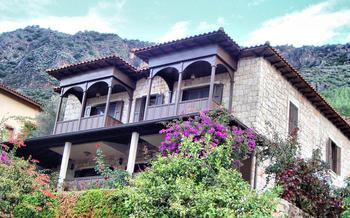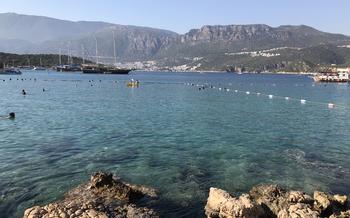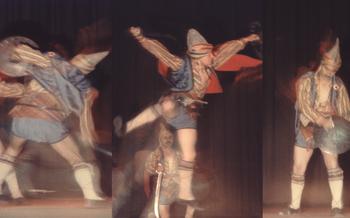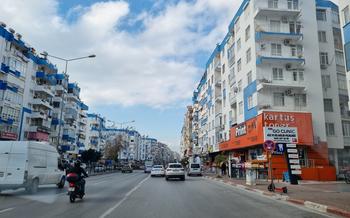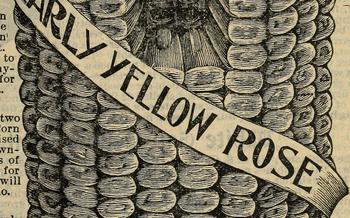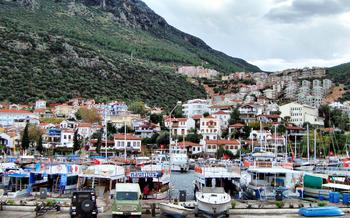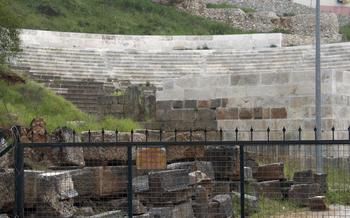
Kas Archaeology Museum
- Kaş Archaeology Museum
- History of Kaş
- Explore the Lycian Sarcophagi
- Marvel at the Hellenistic and Roman Statues
- Uncover the Ancient Jewelry and Coins
- Explore the Pottery and Glassware
- Immerse Yourself in the Museum's Atmosphere
- Learn about the Museum's Research and Conservation Efforts
- Join a Guided Tour for In-Depth Insights
- Plan Your Visit to the Museum
- Capture Memorable Moments
- Respect the Museum and Its Exhibits
- Discover Other Cultural Sites in Kaş
- Insider Tip: Hidden Gem
Kaş Archaeology Museum
The Kaş Archaeology Museum is a treasure trove of ancient artifacts that provide a glimpse into the rich history and diverse cultures that have shaped this captivating town. Situated in the heart of Kaş, the museum houses a remarkable collection of Lycian, Hellenistic, Roman, and Byzantine artifacts excavated from the surrounding region. Its exhibits offer a fascinating journey through Kaş's past, shedding light on the lives, traditions, and artistic achievements of its inhabitants throughout the ages.
The museum's importance lies in its role as a guardian of Kaş's cultural heritage. It preserves and showcases the tangible remains of civilizations that have left an indelible mark on the town's identity. The exhibits not only provide a visual feast but also serve as valuable resources for scholars and researchers, contributing to our understanding of the region's past.
History of Kaş
This captivating town, situated on the Mediterranean coast of Turkey, boasts a rich and diverse history that dates back to the ancient world. In the 5th century BC, Kaş was founded by the Lycians, a seafaring people who established a thriving civilization in the region. The town flourished as a trading hub, connecting the Lycian League with other Mediterranean cultures. During the Hellenistic period, Kaş fell under the influence of Alexander the Great and became a part of the Ptolemaic Kingdom. Subsequently, the Romans conquered the area, leaving a lasting legacy in the form of impressive ruins and artifacts. In the Byzantine era, Kaş was incorporated into the Eastern Roman Empire and served as a strategic port. The town eventually came under Ottoman rule in the 15th century and remained an integral part of the empire until the foundation of the Turkish Republic in 192Today, Kaş stands as a vibrant and cosmopolitan town, proudly preserving its rich cultural heritage while embracing modern-day influences.
Explore the Lycian Sarcophagi
The Lycian sarcophagi are undoubtedly the stars of the Kaş Archaeology Museum, captivating visitors with their intricate carvings and elaborate designs. These impressive stone coffins, dating back to the 4th century BC, offer a glimpse into the rich artistic traditions and beliefs of the ancient Lycians.
The sarcophagi are adorned with a diverse range of motifs, including scenes from mythology, hunting expeditions, and everyday life. The finely detailed carvings depict gods, goddesses, heroes, and mythical creatures, providing valuable insights into Lycian religious beliefs and artistic expression.
The symbolism and iconography of the sarcophagi are particularly intriguing. Many feature the figure of the "Hero," a recurring motif in Lycian art believed to represent a divine or semi-divine being associated with power, protection, and the afterlife.
The discovery and excavation of these magnificent sarcophagi have shed light on the Lycian burial practices and their conceptions of the afterlife. The elaborate carvings and symbolism suggest a belief in a journey to the next world, where the deceased would be accompanied by their worldly possessions and protected by divine guardians.
Marvel at the Hellenistic and Roman Statues
The Kas Archaeology Museum is home to a remarkable collection of Hellenistic and Roman statues, providing a glimpse into the artistic and cultural heritage of the region. These statues depict a pantheon of gods and goddesses, including Zeus, Aphrodite, and Apollo, rendered in exquisite detail and lifelike expressions. Portraits of emperors and officials, such as Alexander the Great and Julius Caesar, offer a window into the political and social history of the period. The statues are crafted from various materials, including marble, bronze, and limestone, showcasing the diverse artistic techniques and styles that flourished during the Hellenistic and Roman periods. The historical context of these statues is particularly captivating, as they provide a tangible connection to the ancient world and the civilizations that once ruled this region.
Uncover the Ancient Jewelry and Coins
Adorned with intricate craftsmanship and exquisite designs, the ancient jewelry on display at the Kaş Archaeology Museum offers a glimpse into the artistry and symbolism of the past. From delicate necklaces and earrings to elaborate bracelets and rings, these precious ornaments once adorned the bodies of Kaş's inhabitants, serving both as personal adornment and symbols of wealth and status.
The museum's collection of coins, minted by various ancient civilizations that ruled over Kaş, provides valuable insights into the economic and political history of the region. These coins, bearing the effigies of rulers and deities, served as a medium of exchange and often carried symbolic messages or commemorated significant events.
By examining these ancient treasures, visitors gain a deeper understanding of the social, economic, and cultural dynamics that shaped Kaş's rich and diverse past.
Explore the Pottery and Glassware
The Kas Archaeology Museum boasts an impressive collection of pottery and glassware, offering a glimpse into the daily lives and artistic traditions of ancient Kaş. Discover a diverse array of ceramic vessels, from utilitarian bowls and jugs to intricately decorated plates and vases. These artifacts showcase the skill and creativity of local artisans, who employed various techniques such as wheel-throwing, hand-building, and glazing to create functional and visually appealing objects.
The museum also houses a significant collection of glassware, including delicate drinking vessels, ornate bottles, and colorful beads. These artifacts provide valuable insights into the ancient glassmaking industry in Kaş, which flourished during the Hellenistic and Roman periods. The intricate designs and vibrant colors of the glassware demonstrate the artistry and technological advancements of the time.
Immerse Yourself in the Museum's Atmosphere
The Kaş Archaeology Museum exudes a tranquil and inviting ambiance that transports visitors back in time. Well-organized and informative displays showcase the rich history and culture of the region, providing a comprehensive journey through the ages. Interactive exhibits and educational programs bring the past to life, allowing visitors to engage with the artifacts and learn about their significance. The museum offers a unique opportunity to immerse oneself in the history and culture of Kaş, creating a lasting impression on every visitor.
Learn about the Museum's Research and Conservation Efforts
The Kaş Archaeology Museum is not merely a repository of ancient artifacts; it is also a hub of ongoing research and conservation efforts dedicated to preserving Kaş's rich cultural heritage. Archaeologists and conservators work tirelessly to uncover new insights into the region's past through ongoing excavations and restoration projects. The museum collaborates with international institutions to share knowledge, expertise, and resources, ensuring that Kaş's cultural legacy is preserved for generations to come. Visitors can learn about these ongoing efforts through informative displays, educational programs, and interactive exhibits, gaining a deeper appreciation for the museum's role in safeguarding the treasures of the past.
Join a Guided Tour for In-Depth Insights
Enrich your museum experience with a guided tour led by knowledgeable and passionate experts. These guides bring the museum's exhibits to life through interactive storytelling and historical anecdotes, providing in-depth insights into the ancient civilizations of Kaş. Specialized tours are available for various interests, catering to history buffs, art enthusiasts, and families with children. With a guided tour, you'll gain a deeper understanding of the artifacts, their significance, and the cultural context of ancient Kaş. Immerse yourself in the captivating narratives of the past and leave the museum with a newfound appreciation for the region's rich history.
Plan Your Visit to the Museum
Before embarking on your journey to the Kaş Archaeology Museum, it's essential to plan your visit to make the most of your experience. Firstly, check the museum's operating hours, as they may vary depending on the season or special events. To avoid queues and ensure a smooth entry, consider purchasing tickets online in advance. Alternatively, you can purchase tickets at the museum's entrance.
Allocate sufficient time to explore the museum's exhibits, as there's a wealth of artifacts and information to discover. Set aside at least two hours to fully immerse yourself in the history and culture of Kaş. While exploring the museum, dress comfortably and wear appropriate footwear, as you'll be doing a fair amount of walking.
Capture Memorable Moments
Capture the essence of your visit to the Kaş Archaeology Museum through photography. Let your lens capture the intricate details of the Lycian sarcophagi, the serene expressions of the Hellenistic and Roman statues, and the delicate craftsmanship of the ancient jewelry and coins. Share your experiences with the world on social media, using captivating hashtags and engaging descriptions. Consider starting a travel blog or vlog to document your journey through Kaş's rich history and culture. Your visual storytelling will not only serve as a reminder of your visit but also inspire others to embark on their own explorations of this ancient land.
Respect the Museum and Its Exhibits
As you explore the Kas Archaeology Museum, it is crucial to show respect for the artifacts and the institution itself. Handle the displays with care, refraining from touching or leaning on them. Follow the museum's guidelines and regulations to ensure the preservation of these valuable pieces of history. Remember, these artifacts are not just objects; they are priceless remnants of past civilizations, representing the rich cultural heritage of Kaş. By treating them with respect, you are not only preserving them for future generations but also demonstrating your appreciation for the history and culture they embody.
Discover Other Cultural Sites in Kaş
While in Kaş, take the opportunity to explore other captivating cultural sites that showcase the region's rich history and diverse heritage. Delve into the past at the ancient theater of Antiphellos, where you can envision the grandeur of performances that once took place within its stone walls. Immerse yourself in the mystical allure of Kekova, a sunken city partially submerged beneath the turquoise waters, revealing ancient ruins and remnants of a bygone era.
Stroll through the vibrant weekly market, a bustling hub of local culture and commerce. Engage with friendly vendors, discover unique handicrafts, savor the aromas of traditional Turkish cuisine, and immerse yourself in the vibrant energy of this lively gathering. Beyond the town's cultural offerings, Kaş is surrounded by breathtaking natural beauty. Embark on a scenic hike along the dramatic cliffs, marvel at the panoramic views of the Mediterranean Sea, and uncover hidden coves and secluded beaches. Discover the unspoiled beauty of the region, where nature and culture harmoniously intertwine.
Insider Tip: Hidden Gem
Complement your visit to the Kaş Archaeology Museum with a trip to the enchanting Kaputaş Beach, located just a short drive away. This hidden gem offers a breathtaking oasis of crystal-clear turquoise waters, golden sands, and dramatic limestone cliffs. Immerse yourself in the tranquility of this secluded haven, snorkel or dive among vibrant marine life, and bask in the warm Mediterranean sunshine. Capture stunning photographs of the picturesque landscape and create lasting memories of your journey through the history and natural wonders of Kaş.

